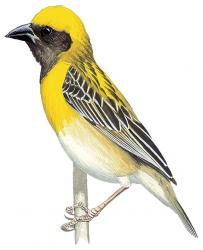A week-long survey, conducted throughout the country to count the number of Weaver Baya (Ploceus philippinus), did not find a single bird in Delhi and the areas around it. The Bombay Natural History Society (BNHS), an NGO involved in conservation and biodiversity research, conducted the bird monitoring programme. The bird watcher spotted only 880 individual Baya throughout the country between June 4 and 10. According to officials, while not a single bird was spotted in Delhi and National Capital Region (NCR), a total of 56 birds were spotted during a two-hour walk at the Bhindawas Bird Sanctuary in Haryana's Jhajjar district, about 52 km from here.
"About five years back there were many Baya in Delhi" Mugdha Singh, Education officer at Conservation Education Centre (CEC) Delhi - a sanctuary runs by BNHS - told IANS.
Baya are colony birds and male construct the nests around the mating seasons to attract the females. According to experts, on an average it takes about 15-20 days to construct a nest. They forage in flocks for seeds, both on the plants and on the ground. Flocks fly in close formations, often performing complicated manoeuvres. They are known to glean paddy and other grain in harvested fields, and occasionally damage ripening crops and are therefore sometimes considered as pests. They roost in reed-beds bordering waterbodies. They depend on wild grasses such as Guinea grass as well as crops like rice for both their food (feeding on seedlings in the germination stage as well as on early stages of grain) and nesting material. They also feed on insects (including butterflies, sometimes taking small frogs, geckos and molluscs, especially to feed their young.
Sources:
Business Standard, June 10, 2017
http://www.business-standard.com/article/news-ians/once-common-weavers-…
Wikipedia
https://en.wikipedia.org/wiki/Baya_weaver

- Login om te reageren
